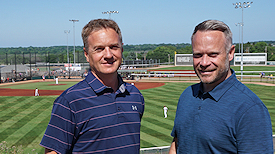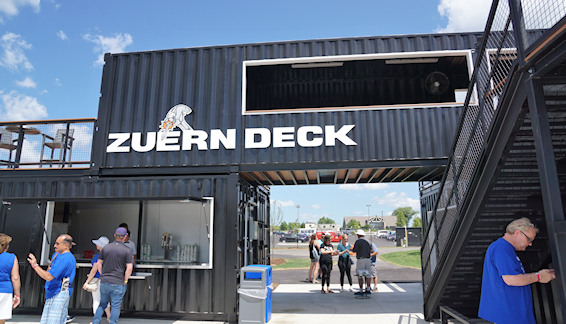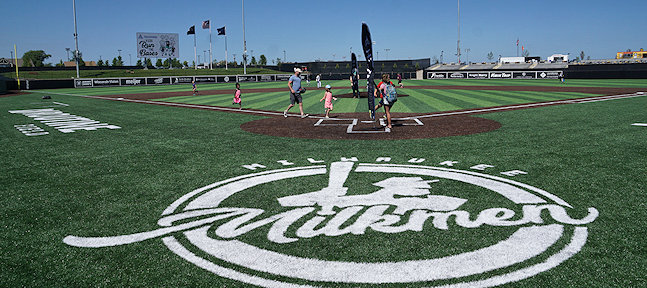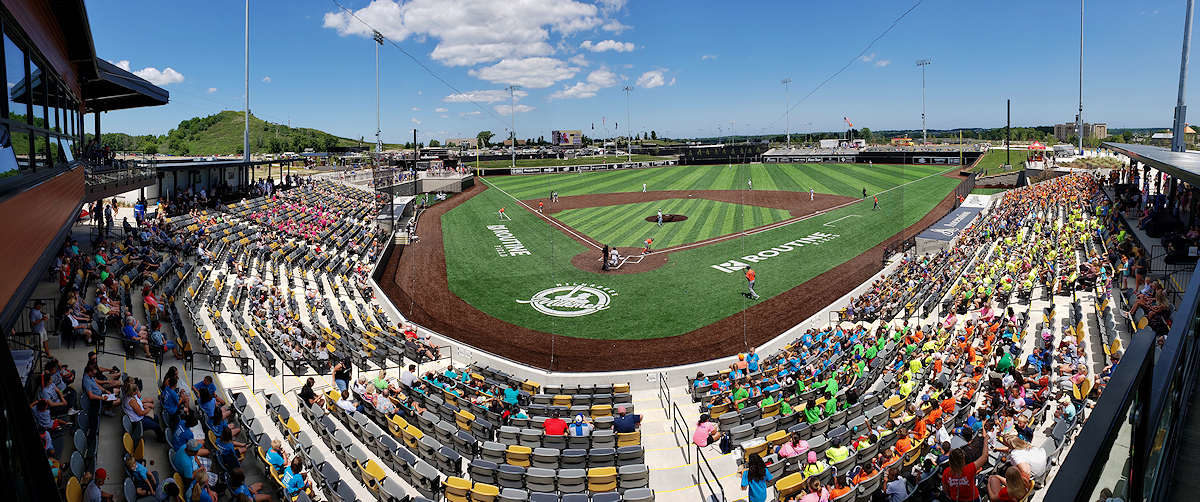Article and all photos by Joe Mock, BaseballParks.com
All rights reserved
FRANKLIN, WISCONSIN Whether you’re a multi-million-dollar investor or simply someone who has a few bucks in a savings account, you want your money to grow. That’s why three of the most important letters in the financial world are R-O-I, or Return On Investment.
| Ballpark Stats |
 |
| Team: Milwaukee Milkmen of the independent American Association |
| First game: June 24, 2019, a 3-2 loss to the Gary SouthShore RailCats |
| Capacity: 4,000 |
| Dimensions: LF – 330; CF – 408; RF – 330. |
| Architect: Tredo Group |
| Construction: Marso on the seating bowl and Stevens on the structures |
| Price: $20 million |
| Home dugout: 3B side |
| Field points: Northeast |
| Playing surface: artificial, including infield and mound |
| Naming rights: Routine Baseball, a sports-apparel company headquartered in Franklin, WI |
| Ticket info: www.milwaukeemilkmen.com/tickets |
| Betcha didn’t know: The entire Rock Sports Complex was constructed on a landfill |
And for much of his life, ROI was critically important to Mike Zimmerman. His Milwaukee firm specialized in the healthcare sector of the private-equity arena. The returns on his investments were indeed quite positive.
Six years ago, his focus changed because of a project he undertook in the Milwaukee suburb of Franklin. “I started the Rock Sports Complex as a philanthropy move, because I live here,” he explained. “I saw how it shaped the community.”
He turned the sprawling Crystal Ridge Landfill into a bustling complex of six top-notch baseball fields. The dimensions of each playing field are patterned after a different Major League ballpark. Now instead of dump trucks hauling trash here, 2,200 baseball games are played each year in the complex.
Recognizing the good that could come from a project like this, Zimmerman felt the need to steer the goal of his investing away from financial returns. With the new focus came a new name for his company.
“We changed the name to ROC Ventures,” he said. “It’s really important what ‘ROC’ stands for, which is Return On Community. It felt like a better brand for what we represent. Sometimes it may not make great financial sense to do something, but we will often look beyond income statements” in taking on a project.
A great example of this occurred in upstate New York. ROC started a summer collegiate team in Jamestown after the town’s New York Penn League team left. They got it running, won a league championship, and then donated the franchise to the city.
Which leads us to a tract of land on the western side of the former landfill in Franklin. Zimmerman said he wanted to own a baseball team closer to home. He ruled out affiliated Minor League Baseball “for obvious reasons,” since Franklin is only nine miles from the Brewers’ Miller Park.
In order for ROC to move forward on constructing a professional ballpark within the Rock Sports Complex — as well as launching plans for a mixed-use development called Ballpark Commons adjacent to it — the firm took the unusual step of offering to purchase the land the complex was built on. Remember, this land was a landfill. In September of 2017, the Milwaukee County Board of Supervisors agreed to the sale. The team that would become the Milwaukee Milkmen, the independent-league team that Zimmerman intended to launch, would have a place to construct a stadium – with all of the complications that building on a landfill entailed.
| Returning to the community |
 |
| ROC Ventures gives back to the community in ways like the Rock Sports Complex, which they built in Franklin. Here COO Dan Kuenzi and Owner Mike Zimmerman stand in front of a cloverleaf of fields at the complex. |
That stadium became Routine Field, named for Routine Baseball, an apparel company headquartered in Franklin.
When asked what companies were involved in designing and building the 4,000-seat ballpark, Zimmerman replied, “It’s a lot.” He went on to list JSD as the civil engineer, Sigma as the environmental engineer, Tredo Group as the architects, Marso as the contractor on the seating bowl and Stevens Construction as the one for the structures surrounding the bowl.
Early on, he brought in noted sports architect Jonathan Cole of Pendulum Studios “to help with the original vision” of the project. Cole, of course, designed Dunkin’ Donuts Park in Hartford, the 2017 Baseballparks.com Ballpark of the Year, and the Atlanta Braves’ new spring training stadium which opened in March.
Zimmerman admits that “it was a lot of people involved, and it made it complicated, but we got a better work product out of it.”
He also concedes that unlike American Association foes the St. Paul Saints and Chicago Dogs, “this is not a $60 million stadium. It cost under $20 million, and because we’re paying for it ourselves, we have to be mindful of how all of this works.”
By no means is Routine Field as ambitious a project as the stadiums in St. Paul or Chicago, but an unmistakable comparison is that both of those teams operate in a very large metro area with Major League teams close by — as do the Milkmen. That bodes very well for success in Franklin, as the Saints and the Dogs sit atop the American Association in attendance.
But even though Routine Field’s construction cost is roughly a third of either of those two parks, that doesn’t mean it lacks interesting features or fan amenities.
Tredo’s Alex Van Osten, the lead designer of the park, said that there are a lot of compelling design features. In addition to traditional seats in the bowl and a grassy berm in the outfield, fans can enjoy luxury cabanas, VIP suites with exterior decks and the Leinenkugel Hop Yard beer garden with both tables and group seating. “All of these areas are designed to have optimal sightlines and provide an ample amount of circulation/elbow room,” he explained. “Many of these amenities do exist at other professional stadiums around the country, but I think what makes our design unique is the fact that we were challenged to build this park on an existing landfill with a very aggressive timetable (of less than a year) and at a fraction of the cost of other similarly sized facilities.”
But there’s no getting away from the fact that all of this was built on what used to be a dump. “Building on a landfill requires a lot of time spent on the design and selection of the foundation systems,” he added. “The solution in this case was to create a network of aggregated grade beams and mat slabs as needed to support the buildings. These are largely underground structural systems that tie the entire building foundation into a singular piece. This allows for anticipated movement or settlement and prevents catastrophic damage to the building.”
If you’ve been unfortunate enough to scrutinize a landfill, you noticed that there has to be a way for gases to escape when what’s beneath the ground decomposes. “The entire stadium has a complex grid of pipes underneath it to collect methane from the soil and actively exhaust the gas as designed in select locations on site. We spent a lot of our efforts focused on the foundation design and coordination across disciplines to get this element right for this unique site.”

One can’t help but notice the use of old storage containers being repurposed at the facility. Yes, that’s a “green” thing to do, but there was another reason for their use (and if you guessed it’s because of the landfill underneath, you’re right). Zimmerman noted that there were lots of concerns about building here, “but ‘settlement’ is a really big one.” They realized if they used big metal storage containers to house some of the facilities, then if it starts to settle, the whole structure settles. So much thought went into this that Zimmerman joked that he should be given credit for originating the idea of utilizing such containers in construction projects!

A particularly ingenious aspect of Routine Field is what happens in the offseason. “The stadium is also designed to completely shut down in the winter. At the end of the season, the owner locks the door and walks away. In Wisconsin this means that the facility will freeze in the winter and the ownership will benefit by saving money on heating and facility costs,” Van Osten elaborated. “Designing the facility to freeze in the winter adds complications for the design of the foundations. We had to fully insulate underneath each building to prevent the potential frost heave associated with allowing a building to fully freeze.”
Zimmerman summed everything up by listing his three priorities when he was planning to build Routine Field. First, the structure behind home plate had to be designed perfectly, because it contains concessions on the ground level and luxury suites and the pressbox on the upper level. “This was a really important component,” he stressed.
Second was the Hop Yard beer garden down the third base line, constructed from those aforementioned storage containers. “That’s an all-inclusive ticket, and it is selling really well,” he pointed out.

Third was the synthetic turf — but the artificial surface isn’t just replacing what would be grass at another ballpark. No, it is everywhere, including the “skin” of the infield, the batter’s circle and even the pitcher’s mound. “In this climate, you have to have synthetic (turf), especially with the number of games we want to churn through this sucker,” Zimmerman said.
He’s certainly pleased with how the stadium turned out — and he’s enjoying the reaction of the fans. “When you drive up, you can’t really tell what the stadium looks like. Then when people walk in, they’re like ‘Whoa, didn’t expect that!'”
So I guess you could say that instead of having a “wow factor,” the park has a “whoa factor.”
But whether it’s Wow or Whoa, Routine Field is anything but routine. It warrants a visit the next time you’re in the Milwaukee area.
